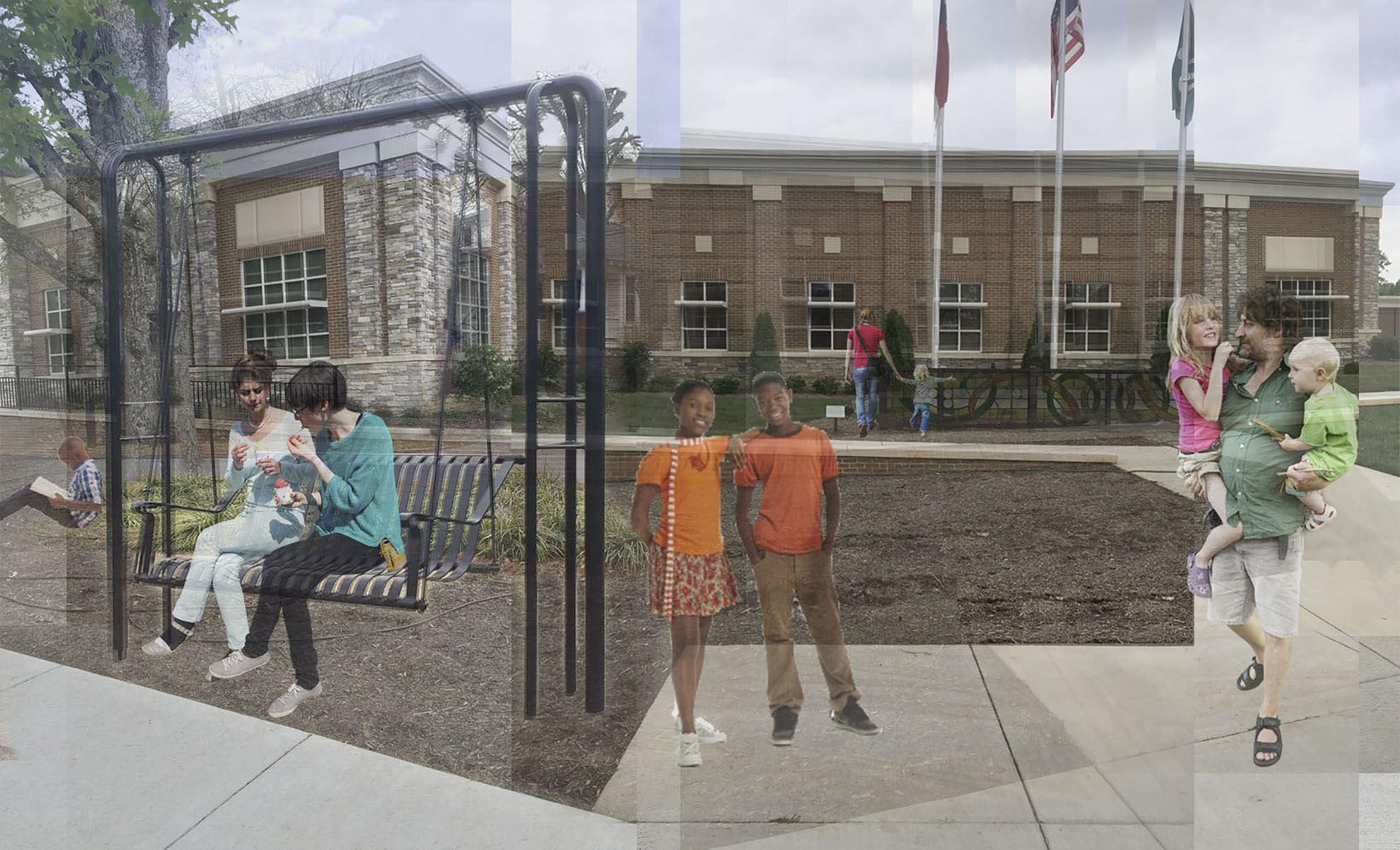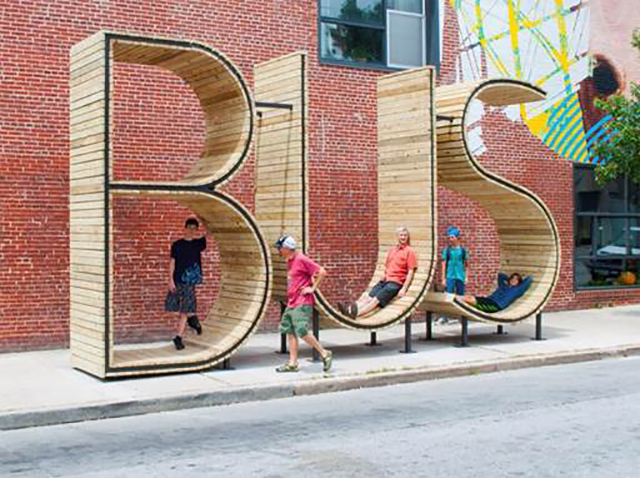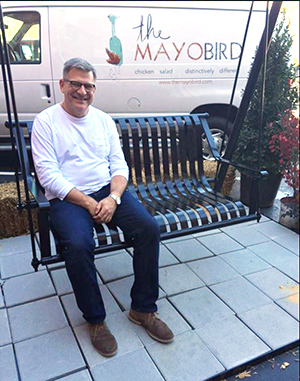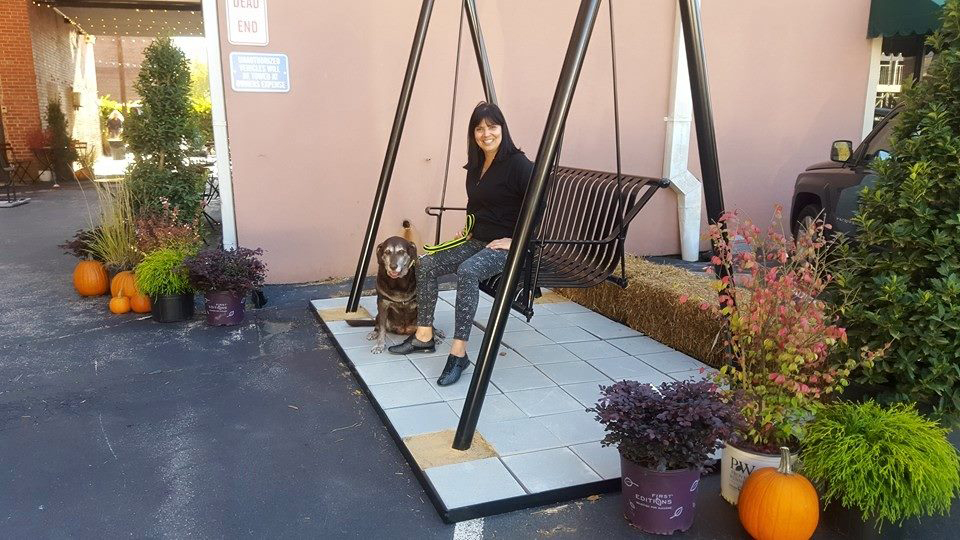
Porch swings in public places foster new conversations in Charlotte, N.C.
Tom Warshauer is community engagement manager for the city of Charlotte, a winner of the 2015 Knight Cities Challenge, which seeks the best ideas to make one or more of the 26 Knight communities more successful using talent, opportunity or engagement. Apply at knightcities.org. Above: What if we can move bus stops from lonely places to “porches” where community interaction is encouraged and celebrated?
People can get really excited about light rail projects. From cool, ultra-modern rail cars to art-infused, interactive stops that enhance the riders experience, light rail is one of the sexier modes of public transportation. When it comes to bus stops and particularly those along local, neighborhood routes, words like “sexy,” “artistic” and “enhanced rider experience” generally aren’t part of the vocabulary. Bus riders simply aren’t treated with the same amenities as other modes of transit. What if they were? What if the transit experience was equitable no matter where you live or what public transit was available? What if bus stops provided amenities such as free Wi-Fi or drinking fountains? What if neighborhoods felt empowered to adopt bus stops in their communities? What if major employers adopted the bus stops on their campuses and invested in the ridership experience of their employees and customers much like they invest in covered parking garages for auto transit?
These questions have kept me up at night, thinking that there must be a better way. This led to our Knight Cities Challenge last year to install “front porch swings” at or near bus stops – both school bus stops and public transit bus stops. After all, before the advent of air conditioning, the Southern home was not complete without the quintessential front porch where neighbors could easily communicate from porch to porch and build community. What if, by installing porch swings at bus stops, we can move bus stops from being lonely places to civic front “porches” where community interaction is encouraged and celebrated?

What if bus stops became places where people enjoyed waiting for the bus?
Charlotte is a big city. Lots of people, lots of neighborhoods, lots of streets. So, where to get started with this idea? Central Avenue is one of the most linguistically and ethnically diverse areas in Charlotte, and perhaps in the state. It is one of the busiest routes in the Charlotte Area Transit System bus network. Portions of the corridor have experienced a surge of new development, becoming increasingly attractive to millennials. Swings along this corridor would welcome and unite these diverse communities.
Six months into the project we’ve accomplished a lot, but there is plenty more to do. We’ve tested a prototype of the swing at a temporary Neighborhood Living Room installation and received great feedback. Overall we plan to install four to six swings in the corridor with the goal of creating public places where community connections occur organically. People from all over the city have been excited about the swings and the opportunity to make improvements at bus stops. That was a big part of the project: getting the community excited about the possibilities to enjoy their bus experience, including the waiting. Here’s what we’ve learned:

Author Tom Warshauer enjoying a swing.
· Be clear about what you’re trying to accomplish: Early on we produced a document that gave the history of the project and presented our research on the best candidates for possible swing locations – those with high ridership, pleasant places to swing under trees or in grassy yards, and a flat topography so that installation would be easy. Having a professional document that explains the process makes it real and helps prospective property owners understand why they are being asked to partner in the project.
· Identify project champions and build on their support: While we’ve had great reception from most property owners, there was an owner who wasn’t interested in talking to us at all. With a project like this it’s important to identify those who understand what you’re trying to accomplish and how they fit into the larger community picture. When faced with a naysayer – and you invariably will be – remember that not everyone has arrived at the same place (which is totally OK) and move on quickly to supporters who are enthusiastic about participating.
· Prepare for maintenance and liability issues: We’re fortunate to have experienced risk management staff to help us work through these issues for the swings that will be installed on public property (e.g. police division headquarters). For the private-sector component, working with owners that have maintenance infrastructure in place, such as churches and apartments, has proven to be helpful. They understand the nuances involved and have processes to manage them. To further help with this we worked with a local fabricator familiar with public-use issues. They intentionally designed a swing with limited “pinch-points” and durable materials to help us get in front of the maintenance and liability issues.
· Build in flexibility: What happens if a swing is installed and the property owner has second thoughts? To allow for this we identified a way to donate the swing outright to the property owners with the caveat that if they don’t like it, they can return it. In this way the owner has full autonomy to determine if the swing works for their unique setting or not. At the same time we are able to eliminate the time-consuming process of acquiring property easements as well as the responsibility for the maintenance of every swing. We believe that if a property owner ends up not liking a swing that there will be others eager to have one on their property.
· Seek alternative opportunities to accomplish your goal: We realized that we didn’t need to have swings at the actual transit bus stops themselves. Locating a swing adjacent to the bus stop is as good as being a part of the stop itself. This was helpful for us in collaborating with our local transit agency, which expressed reluctance in allowing deviations to their standard bus stop footprint and design. While being a part of the actual bus stop would have required land acquisition—very expensive and outside of our budget anyway – we were able to determine that it really isn’t necessary to produce the opportunity we needed.
· Experiment, adapt, repeat: We see this project as being iterative; that’s one of the things that the Knight Cities Challenge taught us. While swings will be a great first step, and hopefully will serve as a template for other areas of the city, the possibilities for creating amenities at bus stops is endless. Adding little free libraries, water fountains and gardens at the stops are things that we are encouraging businesses, community groups and residents to feel empowered to do. We have a neighborhood matching grant program in place that can help these organizations fund projects such as this. We have found good traction for these additions, and, as we talk about our swing project, more and more interest and enthusiasm – which is just perfect for us

An artist enjoying the Neighborhood Living Room project.
To learn more about Charlotte’s Front Porch Swings and other Charlotte Knight Cities Challenge projects, visit the city of Charlotte’s civic innovation website. Here’s hoping that you, too, will be inspired to take action to change your community.
Apply to the Knight Cities Challenge, a $5 million initiative to make the 26 Knight communities more successful. For the latest information on the challenge, be sure to follow @knightfdn and #knightcities on Twitter or sign up for our email newsletter. Send questions to [email protected]. And you can peruse the winners of the first Knight Cities Challenge and apply – by noon ET on Tuesday, Oct. 27, 2015 – at knightcities.org.
Recent Content
-
Community Impactarticle ·
-
Community Impactarticle ·
-
Community Impactarticle ·


